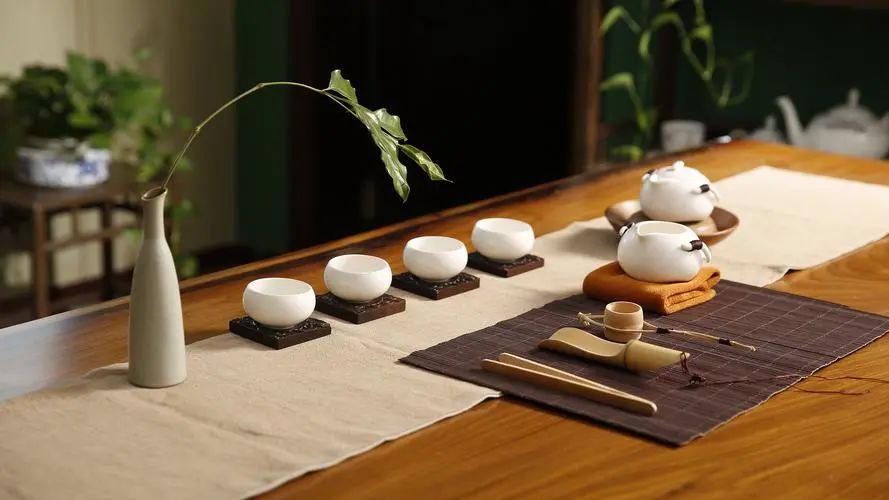As the weather gets hotter, it’s time to show off our arms and legs, and various shopping platforms start recommending fitness equipment. As a fitness novice with many stationery items, I didn’t understand the purpose of these tools and ended up buying whatever I saw. The result was a pile of fitness equipment at home, with a lot of money wasted, and I still don’t know how to use them well. This reminds me of when I first started learning about tea, not knowing what tea sets a beginner should use and being persuaded by the shopkeeper to buy a bunch, some of which are still gathering dust in my warehouse.
As someone who has fallen into many pitfalls on the way to buying tea sets, today I’d like to about talk what basic tea sets a tea novice needs to prepare, so as not to waste money unnecessarily!White Porcelain Gaiwan: The gaiwan is divided into three parts – the saucer, the bowl, and the lid, also known as the ‘Three Talents Bowl’ or ‘Three Talents Cup’. The lid represents heaven, the saucer represents earth, and the bowl represents humanity, implying harmony between heaven, earth, and people. As the main tool for brewing tea, there are many types of gaiwans, such as glass gaiwans, white porcelain gaiwans, and pottery gaiwans.
Among them, the most common is the white porcelain gaiwan. The porcelain of the white porcelain gaiwan is fine and dense. Although it looks simple, it does not absorb aroma and taste, which can well restore the taste and aroma of the tea soup. Gaiwans are suitable for brewing dark teas, oolong teas, and can also be used with purple sand pots. If you like green tea or yellow tea, you can prepare a glass cup, and choose one or two according to your actual tea drinking preferences. Gong Dao Cup: The gong dao cup, also known as the tea divider, is mainly used for pouring and dividing tea. It comes in various styles and shapes, with different heights. In the gongfu tea brewing method, gaiwans and gong dao cups often appear in pairs. To avoid the tea soup becoming bitter from over-soaking, it is necessary to pour out the tea in time, usually into the gong dao cup, so that everyone can appreciate the color of the tea soup. Moreover, the gong dao cup can evenly distribute the concentration of the tea soup, and also serve to appropriately settle tea dregs, reduce the temperature of the tea soup, and enhance the tea drinking experience when dividing tea. Tasting Cup: The tasting cup is the tool used for tasting tea and appreciating the color of the tea soup. Usually, for the overall aesthetic coordination, the same material as the gaiwan is chosen, such as white porcelain or purple sand. When choosing a tasting cup, you can follow the principle of ‘small, shallow, and white’. ‘Small’ means that it can be finished in three sips; ‘shallow’ means that water does not stay at the bottom, and ‘white’ can set off the color of the tea. Generally, porcelain tasting cups are the most common. When drinking tea, if you are alone, you can prepare one at will. If there are multiple people drinking tea, it is best to increase them in order according to the rules, so as to give people a comfortable feeling. Tea Tray: The tea tray is not a must-have item and can be decided based on personal needs. Compared with gaiwans, gong dao cups, and tasting cups the, tea tray is not so eye-catching. However, as a tray for holding tea sets, the tea tray is involved in the processes of brewing, dividing, and tasting tea.Overflowing tea soup during brewing, rinsed tea water that is poured away, and other such liquids are well-contained by the tea tray, which simplifies the entire tea brewing scene. Additionally, our country has always upheld the traditional virtue of ‘serving tea to guests’, and the tea tray also serves to enhance aesthetics and reflect the etiquette of serving tea.
A kettle is the cornerstone of tea brewing; without hot water, it is very inconvenient to brew tea. Compared to the past, today’s electric kettles can control the temperature of the water, which is much more convenient. However, the shape of the kettle also has a certain impact on tea brewing. Kettles with short and wide spouts have a large water output and are prone to splashing tea from the lidded bowl onto areas outside the tea tray, even wetting the tea mat. It is recommended that beginners choose kettles with long and slender spouts to accurately pour boiling water into the lidded bowl without mishaps. Finally, for novice tea drinkers, selecting these practical utensils is sufficient. As one delves deeper into the study of tea, one can choose suitable tea utensils at different stages.


